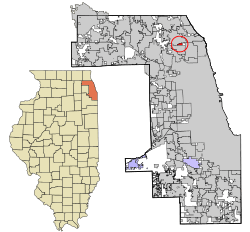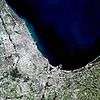Golf, Illinois
Golf is a village in Cook County, Illinois, United States, incorporated in 1928. As of the 2010 census, the village had a population of 500.[3] The community is primarily residential, and has a dedicated police department, post office, and Metra train stop.
Golf, Illinois | |
|---|---|
Village | |
 Location in Cook County and the state of Illinois | |
| Coordinates: 42°03′27″N 87°47′31″W | |
| Country | United States |
| State | Illinois |
| County | Cook County |
| Settled | 1830s |
| Incorporated | 1928 |
| Area | |
| • Total | 0.45 sq mi (1.16 km2) |
| • Land | 0.45 sq mi (1.16 km2) |
| • Water | 0.00 sq mi (0.00 km2) |
| Population (2010) | |
| • Total | 500 |
| • Estimate (2019)[2] | 493 |
| • Density | 1,100.45/sq mi (424.51/km2) |
| Time zone | UTC-6 (CST) |
| • Summer (DST) | UTC-5 (CDT) |
| ZIP Code(s) | 60029 |
| FIPS code | 17-30328 |
| Website | villageofgolf |
Geography
Golf is located at 42°03′27″N 87°47′31″W.[4]
According to the 2010 census, Golf has a total area of 0.45 square miles (1.17 km2), all land.[5]
History
The village of Golf occupies approximately half a square mile in Cook County, Illinois, roughly 17 miles (27 km) northwest of the Loop.
The land which is now the village was originally inhabited by Chippewa, Ottawa, and Potawatomi peoples. It was designated for their settlement in the August 1825 First Treaty of Prairie du Chien.
Around 1830, John Dewes purchased 400 acres (160 ha) for 50 cents an acre from Antoine Ouilmette and became the first non-Indian settler in what is now Golf. Dewes first built a log cabin, then in 1834 he built a brick house - a mansion at the time. Both structures remain on the grounds of what is now the Glen View Club.
In 1897, the Glen View Club bought a portion of the Dewes land and built an 18-hole golf course.
Around 1899, one member, Albert J. Earling, President of the Chicago, Milwaukee and St. Paul Railroad, started taking his private rail car from his offices downtown to golf at the Glen View Golf Club. He would tell people he was "going to golf." Earling arranged to have his car switched to a special siding at what is now the Golf train station. Other members began using Earling's siding, and it soon became a regular stop known as the "golf stop". The siding remained until it was salvaged during World War II to reclaim the steel tracks for use in the war effort, according to residents of Golf at that time.
In 1925 Edward R. Diederich, a Chicago businessman, wanted to buy an acre of land near the Glen View Golf Club to build a country home. He found that in order to get the site he wanted, he would have to purchase a 30-acre (12 ha) tract that was being sold to close an estate. The 30 acres extended from the Golf train station to the Glen View Golf Club boundary. Diederich chose to purchase the land, and had it laid out with winding streets and big lots. He installed sewer, water, gas, and electricity, paved streets, sidewalks, and installed electric street lights. The village of Golf was incorporated in 1928. The Glen View Club was originally outside of Golf village limits until annexation c. 1975.
Demographics
| Historical population | |||
|---|---|---|---|
| Census | Pop. | %± | |
| 1930 | 112 | — | |
| 1940 | 158 | 41.1% | |
| 1950 | 258 | 63.3% | |
| 1960 | 409 | 58.5% | |
| 1970 | 504 | 23.2% | |
| 1980 | 482 | −4.4% | |
| 1990 | 454 | −5.8% | |
| 2000 | 451 | −0.7% | |
| 2010 | 500 | 10.9% | |
| Est. 2019 | 493 | [2] | −1.4% |
| U.S. Decennial Census[6] | |||
As of the census of 2010, there were 500 people, 156 households, and 130 families residing in the village. The population density was 1,111.1 people per square mile (416.7/km2). There were 162 housing units at an average density of 360.0 per square mile (135.0/km2). The racial makeup of the village was 92.0% White, 0.6% Black, 3.0% Asian, 2.4% some other race, and 2.0% two or more races. Hispanic or Latino of any race were 8.2% of the population.[3]
There were 156 households, out of which 41.7% had children under the age of 18 living with them, 79.5% were headed by married couples living together, 0.6% had a female householder with no husband present, and 16.7% were non-families. 16.0% of all households were made up of individuals, and 9.0% were someone living alone who was 65 years of age or older. The average household size was 2.99, and the average family size was 3.38.[3]
In the village, the population was spread out, with 28.6% under the age of 18, 7.8% from 18 to 24, 18.8% from 25 to 44, 28.0% from 45 to 64, and 16.8% who were 65 years of age or older. The median age was 41.8 years. For every 100 females, there were 118.3 males. For every 100 females age 18 and over, there were 125.9 males.[3]
For the period 2007–11, the estimated median annual income for a household in the village was $165,000, and the median income for a family was $167,250. Male full-time workers had a median income of $135,313 versus $115,313 for females. The per capita income for the village was $57,063. 2.7% of families and 2.5% of the population were living below the poverty line, including 3.4% of persons under age 18 and none of those over 64.[7]
Transportation
- The major highways near Golf are Interstates 94 and 294.
- Metra's Milwaukee District North Line stops in Golf.
- Two Pace Suburban Bus service routes are available near the village - routes 208 and 210.
- O'Hare International Airport is approximately 12 miles (19 km) southwest of the village.
Schools
Golf School was built in 1927, just south of the village, at a location that would become 9401 Waukegan Road in Morton Grove, but at the time it was a prototypical country school house, a wooden structure with 4 rooms, no electricity or running water. A 1930s Works Progress Administration project constructed a large brick structure east of the original building. Up until the 1980s, public school students from Golf attended Golf School (K-5), Golf Junior High School and Niles North High School. As demographics changed in the 1980s, Golf residents chose to abandon their namesake primary school district, and align with more upscale school districts in Glenview.
Currently students from Golf attending public school go to District 34 Lyon and Pleasant Ridge Elementary Schools, Springman Middle School, and District 225 Glenbrook South High School.
A number of students also attend the local private Catholic schools Our Lady of Perpetual Help, Regina Dominican High School, and Loyola Academy. North Shore Country Day School is another private school option.
Town events
The Golf Civic Association plans five social activities for villagers each year. The events include a winter party, 4 July festivities and fireworks, a fall steak fry, a Halloween haunted house, and the Polar Express.
Trivia
The Village of Golf is known for its rigid speed limits. All residential streets have a speed limit of 20 mph (and one 15 mph) which is strictly enforced by the local police department. The officers also enforce the speed limit on the north side of Golf Road, a major 4 lane roadway on the south border of the Village. Only the westbound lanes of traffic on the north side are within Golf village limits; the corresponding eastbound lanes are in Morton Grove. Despite its small size, the Village has a police officer on-duty 24 hours a day. Currently the Chief of Police is the only full-time law enforcement officer for Golf, but is supplemented by many part-time officers and detectives, who cover the other shifts. The part-time officers are retired police officers and some full-time police officers from nearby jurisdictions. Adjoining villages and the Cook County Sheriff's Office also provide dispatch, patrol and mutual aid services as needed.
Town Crime
The Village of Golf Police Department is located on the north west side of the Metra train station. The one holding cell remains vacant for most of the year due to the lack of crime.
References
- "2019 U.S. Gazetteer Files". United States Census Bureau. Retrieved July 14, 2020.
- "Population and Housing Unit Estimates". United States Census Bureau. May 24, 2020. Retrieved May 27, 2020.
- "Profile of General Population and Housing Characteristics: 2010 Demographic Profile Data (DP-1): Golf village, Illinois". U.S. Census Bureau, American Factfinder. Archived from the original on February 12, 2020. Retrieved March 12, 2013.
- "US Gazetteer files: 2010, 2000, and 1990". United States Census Bureau. 2011-02-12. Retrieved 2011-04-23.
- "G001 - Geographic Identifiers - 2010 Census Summary File 1". United States Census Bureau. Archived from the original on 2020-02-13. Retrieved 2015-08-03.
- "Census of Population and Housing". Census.gov. Retrieved June 4, 2015.
- "Selected Economic Characteristics: 2007-2011 American Community Survey 5-Year Estimates (DP03): Golf village, Illinois". U.S. Census Bureau, American Factfinder. Archived from the original on February 10, 2020. Retrieved March 12, 2013.
External links
| Wikimedia Commons has media related to Golf, Illinois. |
